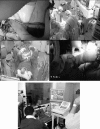A human factors analysis of technical and team skills among surgical trainees during procedural simulations in a simulated operating theatre
- PMID: 16244534
- PMCID: PMC1409864
- DOI: 10.1097/01.sla.0000186298.79308.a8
A human factors analysis of technical and team skills among surgical trainees during procedural simulations in a simulated operating theatre
Abstract
Background: High-risk organizations such as aviation rely on simulations for the training and assessment of technical and team performance. The aim of this study was to develop a simulated environment for surgical trainees using similar principles.
Methods: A total of 27 surgical trainees carried out a simulated procedure in a Simulated Operating Theatre with a standardized OR team. Observation of OR events was carried out by an unobtrusive data collection system: clinical data recorder. Assessment of performance consisted of blinded rating of technical skills, a checklist of technical events, an assessment of communication, and a global rating of team skills by a human factors expert and trained surgical research fellows. The participants underwent a debriefing session, and the face validity of the simulated environment was evaluated.
Results: While technical skills rating discriminated between surgeons according to experience (P = 0.002), there were no differences in terms of the checklist and team skills (P = 0.70). While all trainees were observed to gown/glove and handle sharps correctly, low scores were observed for some key features of communication with other team members. Low scores were obtained by the entire cohort for vigilance. Interobserver reliability was 0.90 and 0.89 for technical and team skills ratings.
Conclusions: The simulated operating theatre could serve as an environment for the development of surgical competence among surgical trainees. Objective, structured, and multimodal assessment of performance during simulated procedures could serve as a basis for focused feedback during training of technical and team skills.
Figures




Comment in
-
Surgical simulation: a vital part of our future.Ann Surg. 2005 Nov;242(5):640-1. doi: 10.1097/01.sla.0000186270.53049.74. Ann Surg. 2005. PMID: 16244535 Free PMC article. No abstract available.
References
-
- Reznick RK. Teaching and testing technical skills. Am J Surg. 1993;165:358–361. - PubMed
-
- Hamdorf JM, Hall JC. Acquiring surgical skills. Br J Surg. 2000;87:28–37. - PubMed
-
- Kaufman HH, Wiegand RL, Tunick RH. Teaching surgeons to operate: principles of psychomotor skills training. Acta Neurochir (Wien). 1987;87:1–7. - PubMed
-
- Reznick R, Regehr G, MacRae H, et al. Testing technical skill via an innovative ‘bench station’ examination. Am J Surg. 1997;173:226–230. - PubMed
Publication types
MeSH terms
LinkOut - more resources
Full Text Sources
Medical

